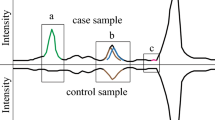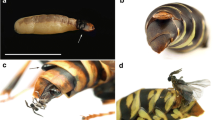Abstract
The isolation and identification of pheromones at the microgram level requires specialized techniques. The pheromones are obtained in the purity required for structural studies by high-speed, high-pressure liquid chromatography using silicic acid- and silver nitrate-treated columns and micropreparative GLC. Then, microchemical reactions, including hydrogenation, ozonolysis, and epoxidation are combined with infrared, nuclear magnetic resonance, and mass spectral studies to elucidate the structure of these compounds. In many cases these techniques are synergistic when combined. Thus, samples of 5–10 μg of most organic compounds under molecular weight 350 are sufficient for complete structural elucidation by using microchemical and spectroscopic techniques. The reduction in sample (2 μg) size necessary for good PMR spectra is significant because the information provided by this technique is often critical to the elucidation of a structure, and sensitivity of PMR has been one of the limiting factors in microspectroscopic analysis.
Similar content being viewed by others
References
Beroza, M., andBierl, B. 1966. Apparatus for ozonolysis of microgram to milligram amounts of compound.Anal. Chem. 38:1976–1977.
Beroza, M., andBierl, B. 1967. Rapid determination of olefin position in organic compounds in microgram range by ozonolysis and gas chromatography.Anal. Chem. 39:1131–1135.
Beroza, M., andSarmiento, R. 1966. Apparatus for reaction chromatography. Instantaneous hydrogenation of unsaturated esters, alcohols, ethers, ketones, and other compound types and determination of their separation factors.Anal. Chem. 38:1042–1047.
Beroza, M., Muschik, G.M., andGentry, C.R. 1973. Small proportion of opposite geometric isomer increases potency of synthetic pheromone of oriental fruit moth.Nature (London), New Biol. 244:149.
Brownlee, R.G., andSilverstein, R.M. 1968. A micro-preparative gas Chromatograph and a modified carbon skeleton determinator.Anal. Chem. 40:2077–2079.
Doolittle, R.E.,Roelofs, W.L.,Solomon, J.D.,Carde, R.T., andBeroza, M. 1973. (Z,E)-3,5-tetradecadien-l-ol acetate: A potent sex attractant for the carpenterworm,Prionoxystus robininae (Peck). Presented at the Symposium on Insect Chemistry, ACS 25th Southeastern Regional Meeting, Charleston, S.C., Nov. 7–9, 1973.
Hunt, D.F.,McEwen, C.N., andUpham, R.A. 1971. Chemical ionization mass spectrometry. II. Differentiation of primary, secondary, and tertiary amines.Tetrahedron Lett. 4539–4542.
Hunt, D.F., McEwen, C.N., andUpham, R.A. 1972. Determination of active hydrogen in organic compounds by chemical ionization mass spectrometry.Anal. Chem. 44:1292–1294.
Hunt, D.F., andRyan, J.F., III. 1971. Chemical ionization mass spectrometry studies. I. Identification of alcohols.Tetrahedron Lett. 4535–4538.
Hunt, D.F., andRyan, J.F., III. 1972a. Argon-water mixtures as reagents for chemical ionization mass spectrometry.Anal. Chem. 44:1306–1309.
Hunt, D.F., andRyan, J.F., III. 1972b. Chemical ionization mass spectrometry studies. Nitric oxide as a reagent gas. J. Chem. Soc. Chem. Commun. 620–621.
King, S.T. 1973. Application of infrared Fourier transform spectroscopy to the analysis of micro samples.J. Agric. Food Chem. 21:526–530.
Majors, R.E. 1972. High performance liquid chromatography on small particle silica gel.Anal. Chem. 44:1722–1726.
Mon, T.R. 1971. Preparation of large bore open tubular columns for GC.Res. Dev. (December) 22 (12): 14–17.
Nakanishi, K., Gullo, V.P., Miura, I., Govindachari, R.T., andViswanathan, N. 1973. Structure of two triterpenes: Application of partially relaxed Fourier transform 13C nuclear magnetic resonance.J. Am. Chem. Soc. 95:6473–6475.
Price, G.O., Sunos, B.C., andWilliams, J.F. 1967. Microcell for obtaining normal contrast infrared solution spectra at the five-microgram level.Anal. Chem. 39:138–140.
Schwartz, N.N., andBlumberg, J.H. 1964. Epoxidations with m-chloroperbenzoic acid.J. Org. Chem. 29:1976–1979.
Tumlinson, J.H., Hardee, D.D., Gueldner, R.C., Thompson, A.C., Hedin, P.A., andMinyard, J.P. 1969. Sex pheromones produced by male boll weevil: Isolation, identification, and synthesis.Science 166:1010–1012.
Tumlinson, J.H., Mitchell, E.R., Browner, S.M., Mayer, M.S., Green, N., Hines, R., andLindquist, D.A. 1972. Cis-7-dodecen-1-ol, a potent inhibitor of the cabbage looper sex pheromone.Environ. Entomol. 1:354–358.
Tumlinson, J.H., Heath, R.R., andDoolittle, R.E. 1974a. Application of chemical ionization mass spectrometry of epoxides to the determination of olefin position in aliphatic chains.Anal. Chem. 46:1309–1312.
Tumlinson, J.H., Yonce, C.E., Doolittle, R.E., Heath, R.R., Gentry, C.R., andMitchell, E.R. 1974b. Sex pheromones and reproductive isolation of the lesser peachtree borer and the peachtree borer.Science 185:614–616.
Vick, K.W., Su, H.C.F., Sower, L.L., Mahany, P.G., andDrummond, P.C. 1974.(Z,E)- 7,11-hexadecadien-1-ol acetate: The sex pheromone of the Angoumois grain moth,Sitotroga cerealella.Experientia 30:17–18.
Author information
Authors and Affiliations
Additional information
Mention of a pesticide or a commercial or proprietary product in this paper does not constitute an endorsement of the product by the USDA.
Rights and permissions
About this article
Cite this article
Tumlinson, J.H., Heath, R.R. Structure elucidation of insect pheromones by microanalytical methods. J Chem Ecol 2, 87–99 (1976). https://doi.org/10.1007/BF00988028
Received:
Revised:
Issue Date:
DOI: https://doi.org/10.1007/BF00988028




